.avif)
.avif)
Most eCommerce brands spend heavily on ads and influencer campaigns, yet many new customers never return. Paid marketing builds visibility but rarely trust, which is what drives sustainable growth. Referred customers make more purchases and bring in 30%–57% more new buyers. HubSpot’s global data shows that 72% of service leaders report higher customer lifetime value when they focus on relationship-based engagement.
So how can you turn that trust into growth for your store? If you’ve struggled to increase repeat sales or inspire genuine recommendations, you’re not alone. This guide explains the referral program meaning, how it works, why it matters, and how to build one that drives real retention. Can turning your happy customers into advocates truly outperform paid ads? Let’s explore.
What You’ll Learn in This Guide
- Referral programs work best when they reward genuine advocacy instead of just transactions, turning customer trust into a growth engine.
- Simplicity drives participation: clear rules, fast rewards, and easy sharing make customers more likely to refer friends repeatedly.
- Referral success depends on emotional motivation as much as incentives; recognition and belonging often outperform discounts.
- Data-backed optimization ensures long-term impact by tracking engagement, conversion, and repeat referrals across campaigns.
- Automation tools like Nector make it easy for small eCommerce teams to run scalable, fraud-free referral programs effortlessly.
Understanding Referral Program Meaning for E-Commerce
A referral program is a structured system that rewards your existing customers for bringing in new ones. It works on a simple idea: people trust recommendations from friends more than ads. For eCommerce stores, this approach builds a self-sustaining loop of acquisition and loyalty. Instead of paying for clicks, you’re rewarding customers who already believe in your brand.
Unlike loyalty programs, which focus on keeping current customers through repeat purchase rewards, referral programs encourage customers to actively bring in new buyers. And unlike affiliate programs, referrals are built on personal connections rather than formal influencer partnerships or commissions. This makes referral programs more authentic, easier to manage, and especially effective for small or founder-led stores that rely on community trust.
Here’s a quick comparison to help you understand the distinction:
Many eCommerce brands use referral programs because they naturally combine trust with scalability. Customers who refer are more emotionally invested in your brand, and referred shoppers often spend more and stay longer. This approach turns customers into advocates, reducing your dependence on ads.
For example, a skincare brand can reward customers who refer friends with store credits or product samples. Each referred friend who makes a purchase earns both the referrer and the new buyer a discount, creating a sense of mutual benefit. This simple setup encourages sharing, builds loyalty, and keeps marketing costs low while fueling steady growth.
Also Read: The Power of Referrals: Implementing a Successful Referral Program in Your Shopify Store
Once you understand what referral programs mean for eCommerce, the next step is to see how they actually work in action.
How a Referral Program Works: Step-by-Step Breakdown
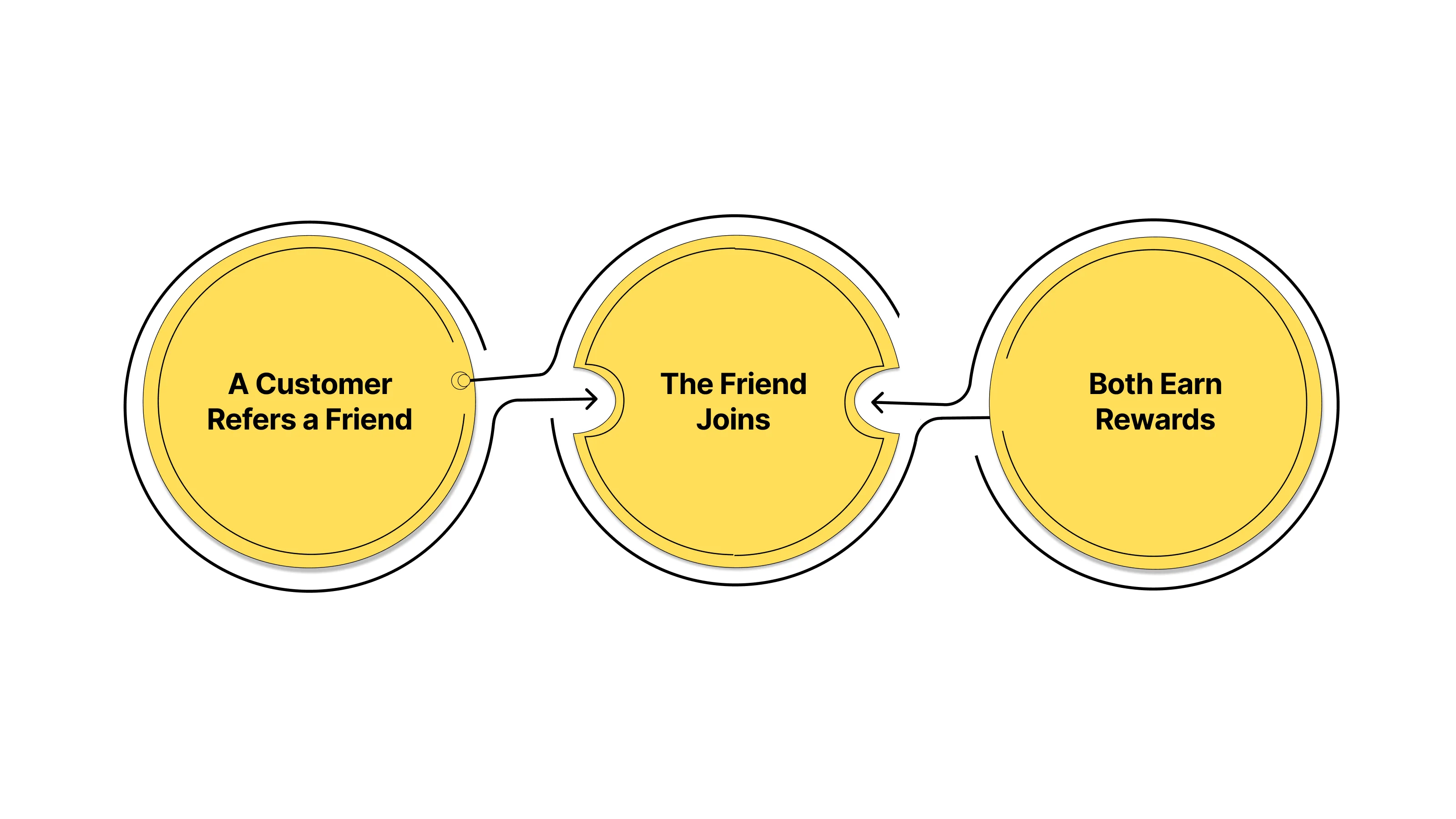
A referral program runs on a simple but powerful flow that rewards both existing and new customers for participating. Each stage needs to be frictionless so customers can move from sharing to rewarding without effort. When the experience is easy, referrals multiply naturally and create steady growth for your store. Here’s how each step typically works inside an eCommerce referral system.
1. A Customer Refers a Friend
Every referral starts when a satisfied customer shares your brand with someone they trust. You can make this process smooth by offering multiple ways to share directly from your store interface.
Common referral triggers include:
- Personal referral links: Customers share unique links with friends through text or social apps, just like how someone might share their favorite coffee subscription with a friend.
- QR codes: Printed on thank-you cards or packaging slips so customers can pass them along easily after delivery.
- Social and messaging options: One-tap sharing through WhatsApp, Instagram, or email built into your store checkout or rewards page.
When sharing takes only seconds, participation rises sharply. Clear CTAs like “Share and Earn $5” or short referral codes customers can copy during checkout make it effortless to spread the word.
2. The Friend Joins or Makes a Purchase
After receiving the link or code, the referred friend lands on your store and signs up or completes a purchase. The system validates this using simple identifiers like email or embedded tracking links to ensure the referral is genuine.
A smooth and transparent process keeps new customers comfortable and engaged. Short welcome banners like “Your friend sent you 10% off your first order” help them understand the benefit immediately.
Tips for frictionless validation:
- Keep forms short with only essential fields like name and email so checkout feels quick.
- Auto-apply referral codes at checkout to remove manual steps.
- Send instant confirmation emails showing both users that the referral was recorded successfully.
Using automation tools such as Shopify’s referral integrations or similar eCommerce plug-ins ensures accuracy and consistency across all transactions.
3. Both Earn Rewards
Once the purchase is confirmed, both the referrer and the new customer receive their rewards. Quick delivery of these rewards builds trust and encourages repeat participation.
Common reward formats include:
- Discounts or vouchers: Offer 10% off for both the referrer and the friend to keep purchases rolling.
- Store credits: Add $10 credit to user accounts instantly so they can apply it to their next order.
- Loyalty points: Award 200 points that contribute to higher loyalty tiers or free gifts.
To help you decide what fits your store best, here’s a quick comparison of different reward types and their ideal use cases:
Referral marketing tips to keep participation high:
- Use visual milestones like “Invite 3 friends to earn a free product” to motivate repeat actions.
- Feature top referrers or customer stories in newsletters to build authenticity and inspire others.
- Test smaller, recurring rewards instead of one-time big incentives to sustain engagement.
When rewards feel fair, fast, and valuable, customers naturally want to share again, turning referrals into a long-term growth cycle for your store.

Turn word-of-mouth into measurable growth. Build referral campaigns that run on autopilot and reward both you and your customers. Start your referral journey with Nector!
Now that you know the steps involved, let’s explore the different types of referral programs that suit various business models.
Types of Referral Programs Used by E-Commerce Stores
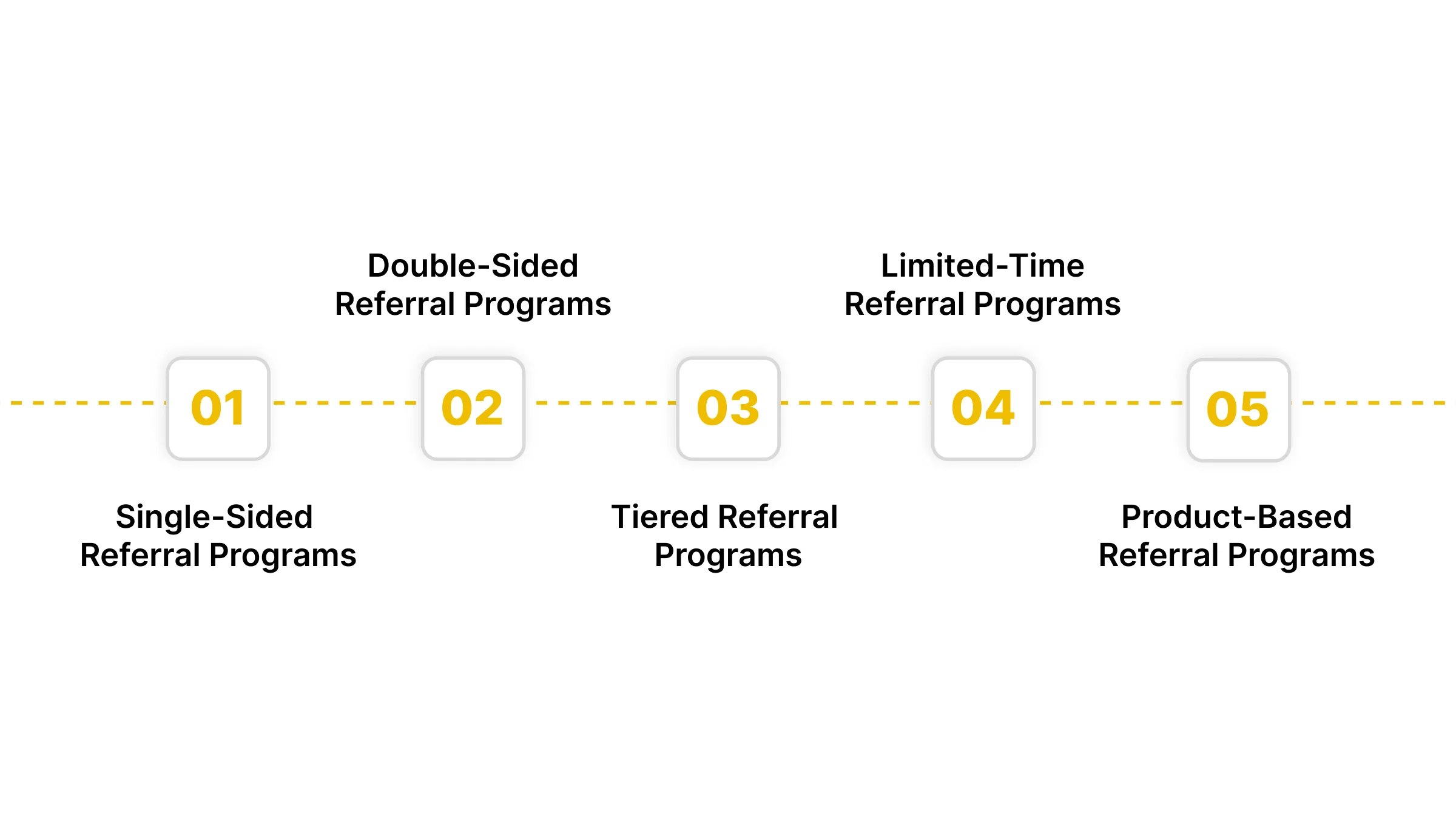
Every eCommerce business runs on different customer dynamics, purchase cycles, and marketing budgets. The structure of your referral program should match these realities. Some programs focus on quick customer acquisition, while others aim to build long-term relationships or boost seasonal sales. The model you choose determines not just how referrals are rewarded but also how customers perceive the value of participating.
A founder-led Shopify store may need a simple, low-maintenance setup, while a mid-sized brand might benefit from gamified tiers or data-driven personalization. Below are the key referral program models used by eCommerce businesses and the type of brands they suit best.
1. Single-Sided Referral Programs
In this setup, only the referrer earns a reward when a new customer joins or makes a purchase. It’s minimal to run and ideal for testing the effectiveness of word-of-mouth promotions before scaling.
- Best for founder-led or early-stage startups with limited resources.
- Keeps operations simple and costs predictable since only one side is rewarded.
- Works well when your existing customers are loyal advocates who already share your brand organically.
- A small apparel store could offer $5 store credit to customers for every friend they refer who places an order.
2. Double-Sided Referral Programs
This is the most balanced and popular structure where both the referrer and the referee are rewarded. It builds trust and fairness, motivating both sides to participate.
- Best for growth-stage brands aiming to increase repeat sales and engagement.
- Creates higher participation since both customers benefit directly.
- Encourages stronger relationships by rewarding shared experiences between friends.
- A skincare brand could offer 15% off to both the existing customer and the new buyer on their next purchase.
3. Tiered Referral Programs
A tiered program adds progression-based rewards, encouraging customers to keep referring over time. Each new tier offers better incentives, creating a sense of achievement and exclusivity.
- Best for mid-sized brands that already have an active repeat customer base.
- Encourages consistent engagement with increasing rewards such as larger discounts or free products.
- Integrates well with loyalty systems, giving customers multiple reasons to stay connected.
- A fitness brand might offer 10% off for the first referral, a free product after three, and early access to new collections after five.
4. Seasonal or Limited-Time Referral Programs
These programs operate within a defined period like during sales campaigns, product launches, or festive seasons, to drive a short-term referral spike.
- Best for startups and growing brands looking to boost conversions during high-traffic periods.
- Builds urgency with clear time limits and exclusive perks.
- Works effectively when paired with marketing campaigns or email blasts.
- An electronics brand could promote “Refer a Friend This Week and Get an Extra $20 Gift Card” during a launch event.
5. Product-Based Referral Programs
Instead of monetary incentives, customers receive free or exclusive products as rewards. This method deepens product engagement and encourages trial of new items.
- Best for D2C lifestyle, beauty, or wellness brands that rely on experience-driven marketing.
- Strengthens emotional connection by turning rewards into tangible value.
- Encourages upselling as customers often purchase more after trying gifted items.
- A wellness store could send a free mini supplement pack to both the referrer and the new customer after a purchase.
Here’s a clear comparison to help you decide which model fits your business goals:
Also Read: How to Design a Referral Program That Drives Repeat Purchases
After learning about the types, it’s time to build one. Here’s how to create a referral program that truly converts.
How to Create a Customer Referral Program That Converts
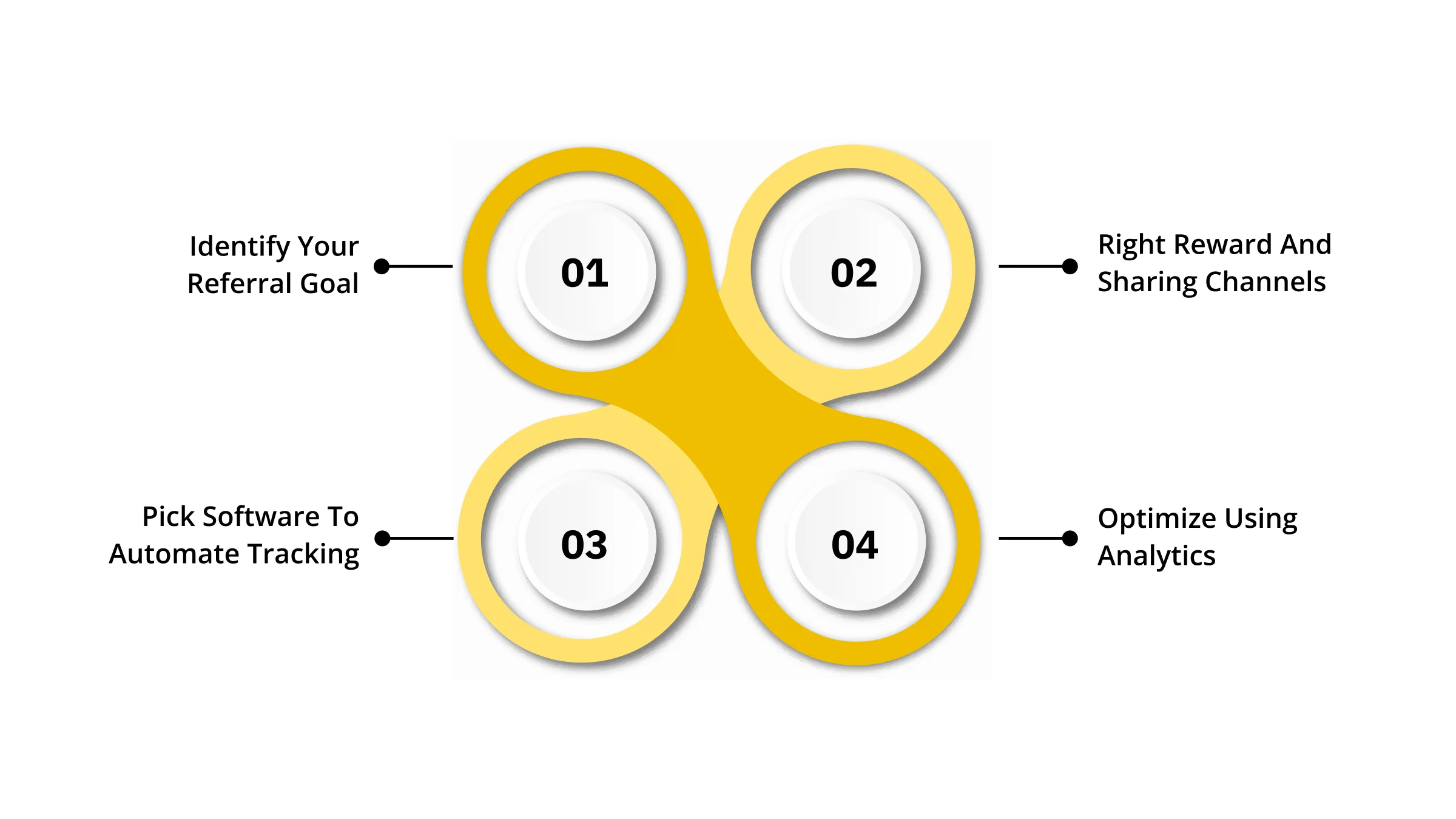
A referral program only works when it’s designed with clarity, consistency, and intent. The most effective ones don’t focus on offering the biggest reward but on removing every obstacle between a happy customer and their ability to share. Each decision from the type of reward to the tracking system affects how naturally customers promote your brand. When your program feels effortless, participation grows without aggressive marketing pushes.
Below is a practical four-step framework to build a referral system that consistently drives measurable results.
1. Identify Your Referral Goal
Start by defining the specific outcome you want your program to achieve. Every referral system performs differently based on whether it’s designed to bring in new customers, improve repeat purchases, or do both.
- Acquisition-focused goals: Reward existing customers when they help you reach new audiences. A lifestyle store could aim for a 25 percent growth in first-time buyers through referral-only offers.
- Retention-focused goals: Strengthen loyalty by giving existing buyers a reason to return. A skincare brand might give referral points that double as credits for future purchases.
- Hybrid goals: Combine both outcomes so that every referral builds community while sustaining lifetime value.
Defining your objective early helps you choose the right incentive and evaluate whether your referral model is driving the intended growth.
2. Choose the Right Reward and Sharing Channels
Your referral success depends on two factors: how meaningful the reward feels and how easily customers can share it. Rewards that match your customers’ interests and frictionless sharing options consistently deliver better results.
- Keep rewards simple and transparent: Offers like “Get $10 when your friend makes their first purchase” perform better than complicated tier systems that require multiple steps.
- Use meaningful incentives: Choose benefits that reflect your product’s value. For example, a health brand could offer a free trial pack instead of a generic discount.
- Enable effortless sharing: Provide one-click sharing buttons for WhatsApp, Instagram, or email. Integrate them directly into your checkout or loyalty dashboard through tools like Shopify’s Referral Apps.
When your customers clearly understand the value and can share it with one tap, participation naturally scales across every channel.
3. Pick Software to Automate Tracking and Fraud Control
Automation is essential once your referral volume grows. Manual processes cause delays, tracking errors, and inconsistent communication. The right referral software ensures accuracy, detects fraud, and keeps customers confident that rewards will arrive on time.
Look for platforms that provide:
- Automatic tracking: Every referral link and purchase should be recorded instantly.
- Fraud protection: Systems must detect duplicate accounts or multiple sign-ups from the same IP.
- Seamless integration: Sync data with your existing stack, such as Shopify, Klaviyo, or WooCommerce, for unified reporting.
Nector gives you the flexibility to customize rules, automate workflows, and view performance data in one dashboard.
4. Launch, Test, and Optimize Using Analytics
Once the system is live, your goal is to refine—not just run—it. Consistent testing shows what motivates customers to share again. Use your analytics dashboard to understand which rewards and communication formats deliver the best conversion rates.
Track key performance indicators such as:
- Referral participation rate: The percentage of customers who engage with the program.
- Referral-to-purchase conversion: The number of referred customers who actually complete an order.
- Repeat referrals: The count of customers who refer multiple times after being rewarded once.
If participation is low, check whether your sharing prompts are visible enough on thank-you pages or post-purchase emails. If conversion is weak, test a simpler incentive or more immediate reward delivery.
Also Read: 15 Best Customer Referral Program Ideas for 2025
Once your referral system is set up, understanding the key elements behind successful programs will help you refine and scale it.
Key Elements That Make a Referral Program Successful
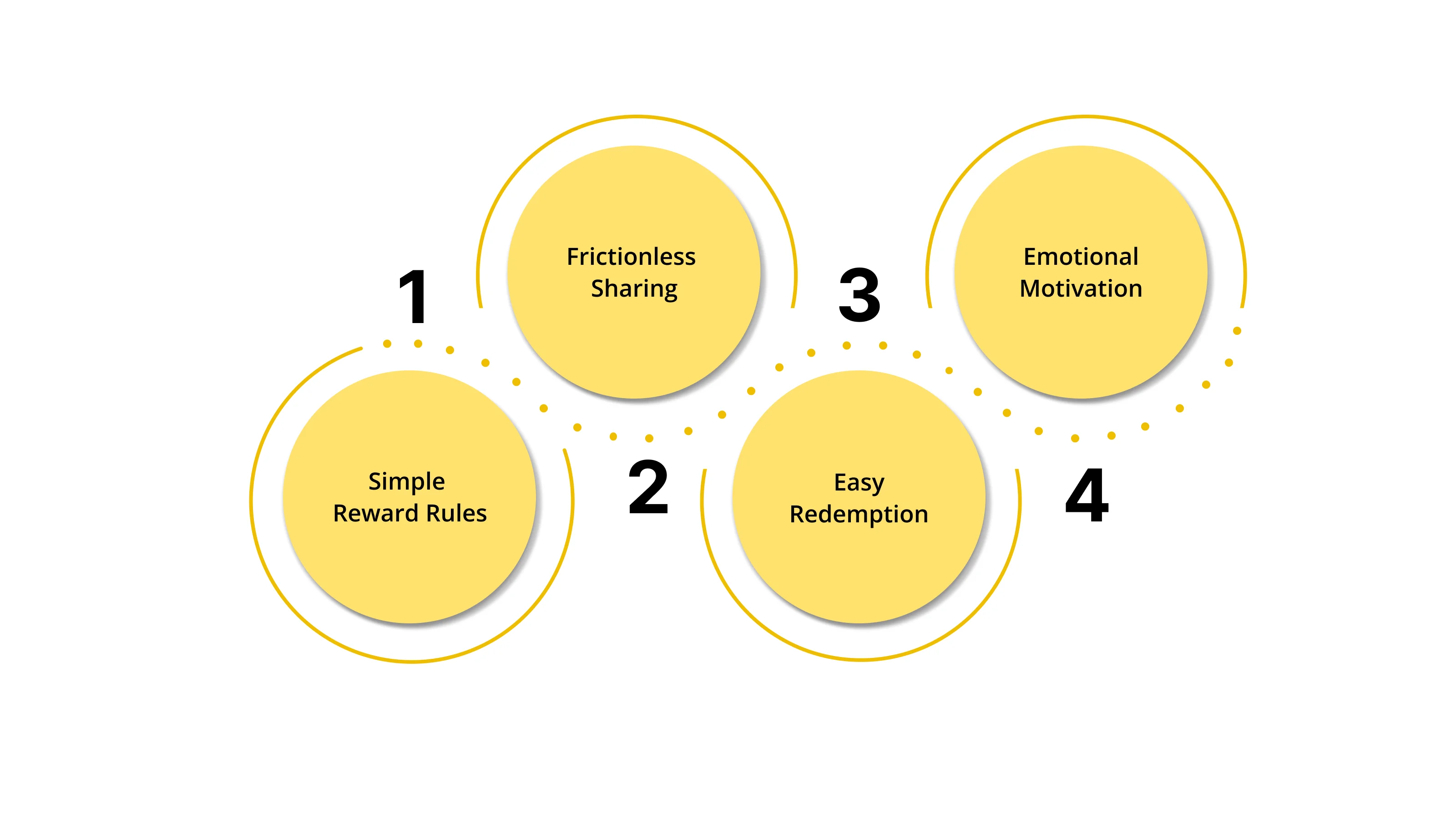
A referral program succeeds when it’s easy to join, quick to use, and rewarding to repeat. Customers participate more when they clearly understand how to earn, feel appreciated for their effort, and experience seamless sharing across devices. The goal is to remove friction and make every referral feel natural instead of transactional.
Below are the essential elements that make a referral system perform well and sustain engagement over time.
- Simple reward rules: Customers should know exactly what they’ll earn and when they’ll receive it. Clear structures like “Get $10 when your friend makes their first purchase” are easier to act on than multi-step conditions. A clear timeline also helps build trust, especially when rewards arrive instantly after validation.
- Frictionless sharing: The referral flow should be accessible across platforms customers already use. Add one-click sharing buttons for WhatsApp, email, and social media within your store interface. Integrations available through Shopify Apps allow this process to stay consistent across checkout and post-purchase pages.
- Easy redemption: Redemption should feel rewarding, not technical. Auto-applying discount codes at checkout or showing points balance on the user’s dashboard keeps the experience simple. When redemption steps are short, participation remains high.
- Emotional motivation: Recognition often motivates customers more than the incentive itself. Features like leaderboards, badges, or thank-you messages turn referrals into moments of appreciation. A short “You just helped us grow” notification can make a bigger impact than another small coupon.
Together, these elements transform referrals from a one-time promotion into a habit customers enjoy repeating. Knowing what drives success also means recognizing what can hold you back. Let’s look at common mistakes to avoid.
Common Mistakes to Avoid in Referral Marketing
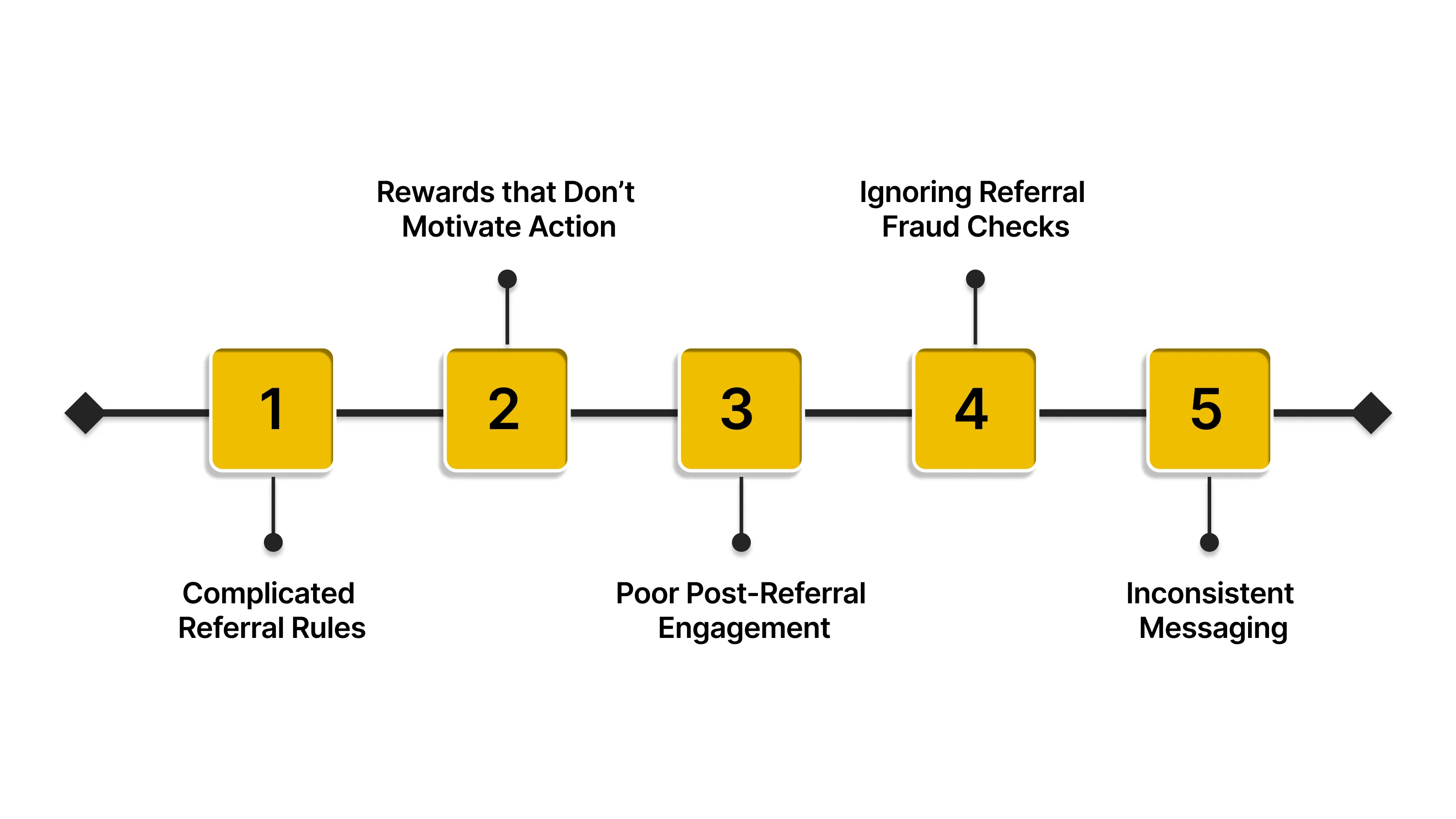
Even a well-designed referral program can fail if execution is inconsistent or overly complicated. Paying attention to user experience and clarity helps prevent issues that discourage participation or harm credibility.
Below are frequent mistakes that reduce referral performance, along with ways to fix them.
- Complicated referral rules: Multi-step rewards or unclear timelines discourage participation. Keep structures simple so customers can act immediately without needing detailed explanations.
- Rewards that don’t motivate action: Incentives must feel valuable and relevant. For instance, a low-value coupon might not excite a loyal buyer, while store credits or exclusive access to limited products could.
- Poor post-referral engagement: The referral process shouldn’t end after the first transaction. Follow up with thank-you messages, badges, or small bonus rewards to acknowledge participation and invite repeat referrals.
- Ignoring referral fraud checks: Duplicate sign-ups or fake referrals can drain your rewards budget. Use automated validation tools like Nector or ReferralCandy to ensure rewards are genuine.
- Inconsistent messaging: If referral terms differ across emails, checkout pages, or social posts, customers lose trust. Keep your messaging unified, so every touchpoint reinforces the same value and reward timeline.
Avoiding these mistakes ensures your referral program feels transparent, reliable, and rewarding for customers. When everything from sharing to recognition works seamlessly, referrals become an ongoing source of growth rather than a short-term campaign.
To see these lessons in practice, here are real-world examples of referral programs that turned customers into advocates.

Real-World Inspiration: Best Referral Program Examples
Referral programs thrive on clarity, trust, and timing. The most successful ones simplify participation, reward both sides fairly, and make sharing feel like a natural extension of the buying experience. You don’t need a large marketing budget to achieve this—many small founder-led stores replicate these frameworks using automated referral tools.
Here are four high-performing referral structures that any eCommerce business can learn from.
- Fashion brand with “Give $20, Get $20” simplicity:
A mid-sized apparel label built its referral program around a dual-reward model that offered $20 to both referrer and referee. Its success came from the clear value exchange and visible progress bar on the referral dashboard. Shoppers could track their shared links, creating satisfaction from seeing direct results. - Meal kit subscription with tiered bonuses:
A food delivery brand introduced milestone-based incentives: free boxes after every three successful referrals. The system gamified participation, motivating customers to share more often. The automation behind it ensured accurate tracking and on-time reward delivery, reinforcing reliability. - Home décor store using referral exclusivity:
Instead of discounts, this store rewarded customers with early access to limited-edition collections when their referrals made purchases. The emotional pull of exclusivity strengthened community loyalty and gave frequent buyers a reason to advocate for the brand. - Eco-conscious wellness brand with product-based rewards:
This D2C store offered free travel-size samples to both referrer and friend after a successful referral. The reward was directly tied to the brand’s core product, allowing new customers to experience quality firsthand while turning existing ones into repeat advocates.
Each of these programs worked because of three common traits; clear benefits, easy sharing, and consistent automation. Whether you’re managing a single-product Shopify store or a scaling brand, these principles can be applied using platforms like Nector or ReferralCandy to create reliable referral experiences.
Also Read: Viral Referral Marketing Strategies and Examples
Seeing what works is useful, but measuring success is essential. Let’s break down the key metrics that define strong referral performance.
Measuring Referral Program Performance: Metrics and Purpose
You can’t improve what you don’t measure. Tracking the right metrics helps you understand whether your referral program drives sustainable growth or just short-term spikes. Metrics should reflect how effectively customers engage, convert, and return after being referred.
Below are the key performance indicators to monitor:
According to PwC’s 2024 Finance Effectiveness Benchmarking Study, referral-driven customers have 16% higher lifetime value, and referral marketing reduces churn while increasing loyalty. This reinforces the idea that referrals bring not just traffic but committed customers.
To optimize performance, use analytics dashboards available in tools like Nector or LoyaltyLion. They provide insights into reward redemption, referral sources, and ROI in real time, allowing you to make data-backed adjustments.
Once you know what to measure, you’ll need the right tools. Here's what to look for in a referral platform.
What Makes a Referral Tool Worth Using? Key Factors to Consider
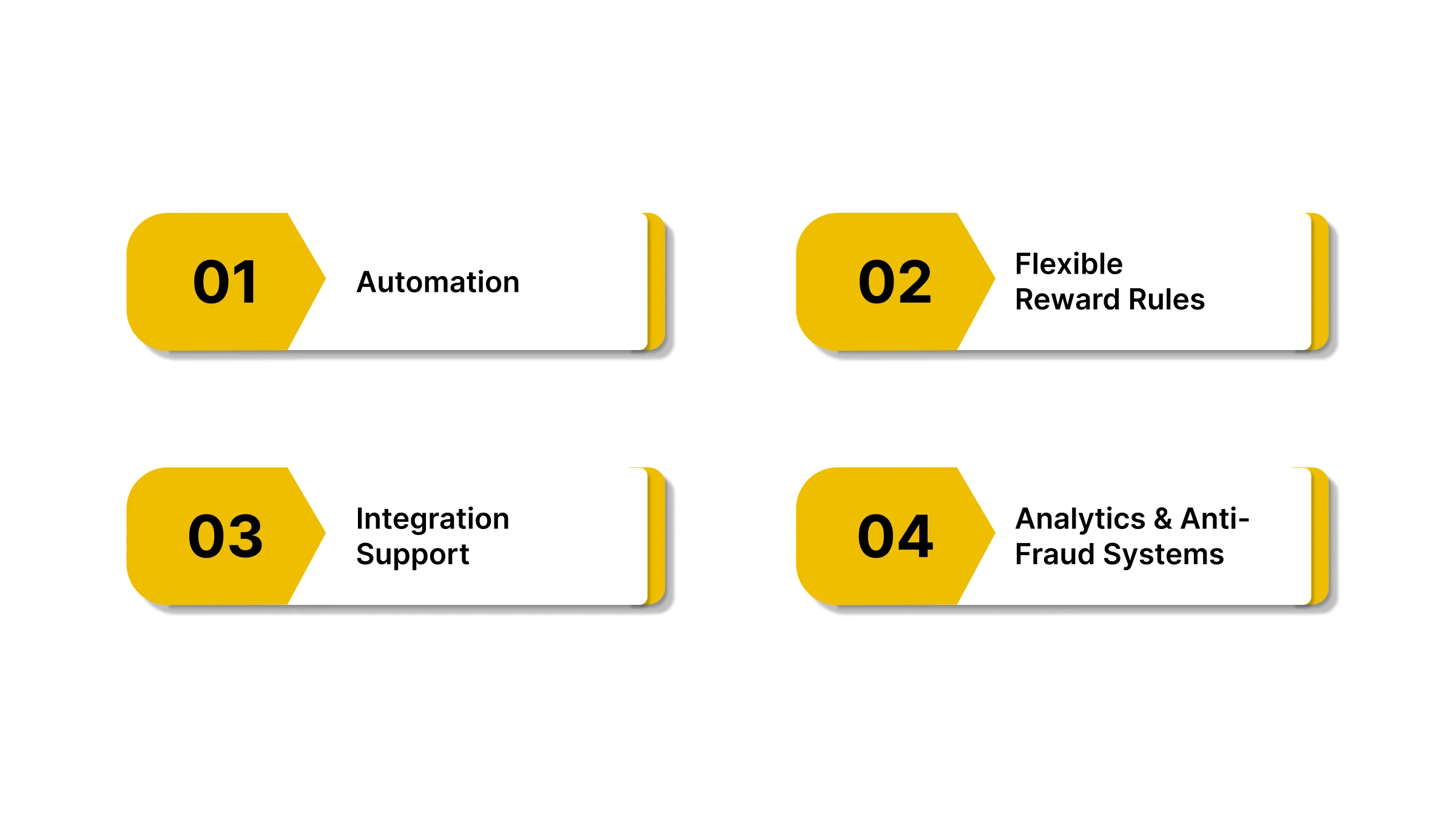
Choosing the right referral software determines whether your program runs effortlessly or becomes a manual burden. A reliable tool should handle everything from tracking and fraud control to messaging automation and analytics.
Here are the features worth prioritizing:
- Automation: Referral tracking, notifications, and rewards should run automatically to eliminate human error and save time.
- Flexible reward rules: The software should allow custom reward structures such as tiered bonuses, store credits, or time-limited campaigns.
- Integration support: Look for compatibility with platforms like Shopify, WooCommerce, Klaviyo, and WhatsApp to connect referral actions with your sales and marketing workflows.
- Analytics and anti-fraud systems: Comprehensive reporting helps monitor real conversions, while fraud prevention features maintain program integrity by detecting duplicate or fake referrals.
That’s where purpose-built platforms simplify the process. Instead of spending hours managing spreadsheets or approvals, automated tools like Nector make it possible to run a fully scalable referral program that’s accurate, data-driven, and easy to maintain.
How Nector Helps You Run Effortless Referral Campaigns Without Extra Work
Managing referrals can quickly become time-consuming when you’re handling everything manually, from reward tracking to message reminders. This is where Nector streamlines the process by automating every major referral workflow while keeping it flexible for your store’s needs. Its focus on simplicity and precision allows even small Shopify teams to run complex referral campaigns without additional staff or resources.
Nector’s referral automation features are built to help you scale efficiently:
- Quick setup with customizable rewards: Create and launch referral programs in minutes. You can set rules for discounts, credits, or loyalty points that match your margins and brand tone. For example, you can configure “Give $10, Get $10” offers or time-bound festive campaigns without any coding.
- Multiple sharing options: Enable one-tap sharing through WhatsApp, email, or SMS, making it easy for customers to invite friends using the platforms they already use daily. This built-in accessibility increases participation while keeping the referral flow frictionless.
- Automatic tracking and fraud detection: Every referral event, from link generation to purchase confirmation, is tracked automatically. Fraud-prevention features monitor duplicate sign-ups or suspicious activity to protect your reward system.
- Integrated analytics dashboard: Track referral performance, conversion rates, and customer engagement in one clean dashboard. You can see which campaigns bring the highest-quality referrals and adjust incentives instantly.
For smaller Shopify teams or founder-led stores, Nector removes the manual work that usually slows down referral programs. Its automation lets you focus on creating meaningful customer relationships while the system handles tracking, validation, and reporting quietly in the background.
How an Amrutham Boosted Referrals and Loyalty with Nector
An Ayurvedic wellness brand known for its authentic lifestyle products, Amrutham, used Nector to turn customer engagement into measurable growth. By connecting loyalty, referrals, and review-based rewards under one platform, the brand transformed every interaction—from purchases to app downloads—into value for both customers and the business.
The Challenge:
The brand had a loyal community and high-value products but struggled to retain repeat buyers without relying on discounts. It needed a unified system to reward advocacy, track engagement, and encourage customers to take actions like writing reviews or installing its app.
The Nector Solution:
With Nector, the brand launched a single rewards ecosystem that combined loyalty coins, referral bonuses, and review-based incentives. Customers earned points for every purchase, app install, and review, while photo reviews offered double rewards. This structure encouraged authentic advocacy and consistent participation without hurting margins.
By using Nector’s unified automation for loyalty and referrals, the brand built a retention engine that rewarded advocacy, increased engagement, and raised average spending; all without adding complexity or manual effort.
Conclusion
Referral programs turn satisfied customers into a powerful source of growth by rewarding authentic advocacy. They work because people trust recommendations from people they know, not advertisements. A well-built referral system reduces your acquisition costs while bringing in high-intent customers who stay longer and spend more. When rewards are simple, sharing is easy, and recognition feels personal, referrals evolve into a reliable driver of both retention and revenue.
This is where Nector fits seamlessly. It helps eCommerce brands build and automate referral campaigns that run smoothly. With customizable rewards, instant tracking, and integrated sharing tools, Nector ensures every referral interaction, from link sharing to reward redemption, remains effortless for both you and your customers. Small teams can handle large-scale advocacy programs without increasing their workload.
If you’re ready to grow through customer advocacy instead of ad budgets, book a free demo with Nector and see how effortless referrals can truly be!
FAQs
Q: How can a referral program help reduce customer acquisition costs?
A: Referral programs bring in high-intent customers through trusted recommendations, lowering ad dependency. Each referral attracts warmer leads who convert faster and stay longer.
Q: What kind of rewards motivate customers to refer consistently?
A: Rewards that feel valuable and personal, such as store credits or exclusive access, keep participation high. Clarity and quick reward delivery increase motivation.
Q: How often should you update your referral program incentives?
A: Update incentives quarterly or during peak sales seasons. Frequent refreshes maintain excitement and prevent reward fatigue among repeat customers.
Q: Can referral programs work effectively for niche eCommerce brands?
A: Yes, niche brands often benefit more because their audience trusts peer recommendations. Targeted incentives amplify community-driven brand advocacy.
Q: What role does automation play in maintaining referral accuracy?
A: Automation eliminates manual tracking errors and ensures timely rewards. Tools like Nector help verify referrals, prevent fraud, and maintain customer trust.
Q: How do you know if your referral program is performing well?
A: Track participation rate, referral-to-purchase conversions, and repeat referrals. A steady increase in quality referrals signals sustainable growth.
FAQs
Start Building Customer Retention That Lasts


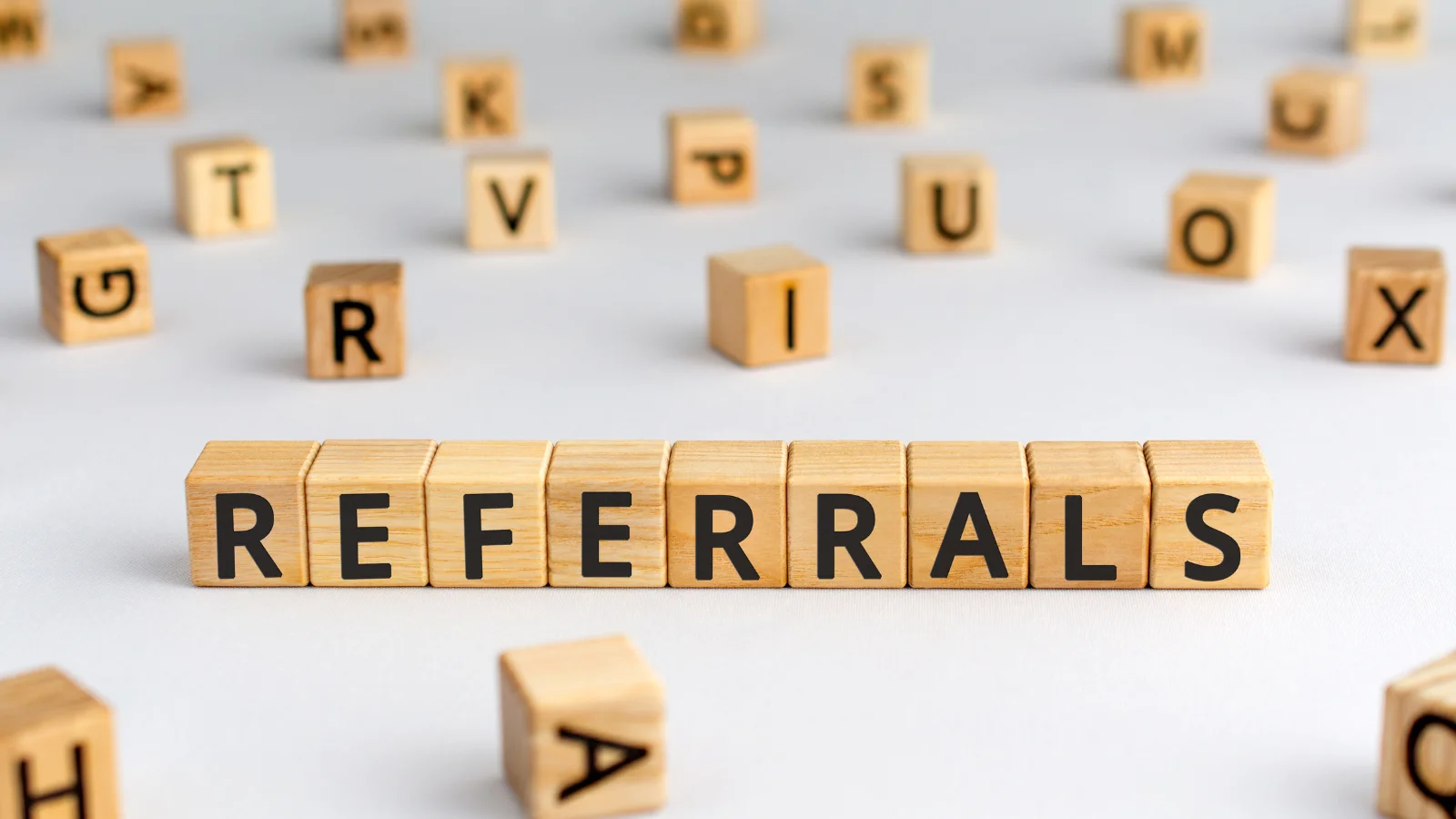

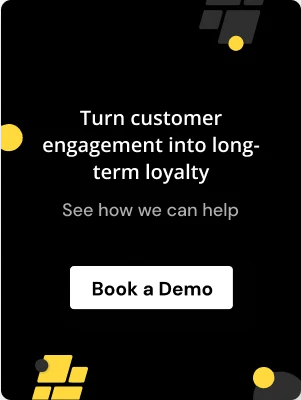
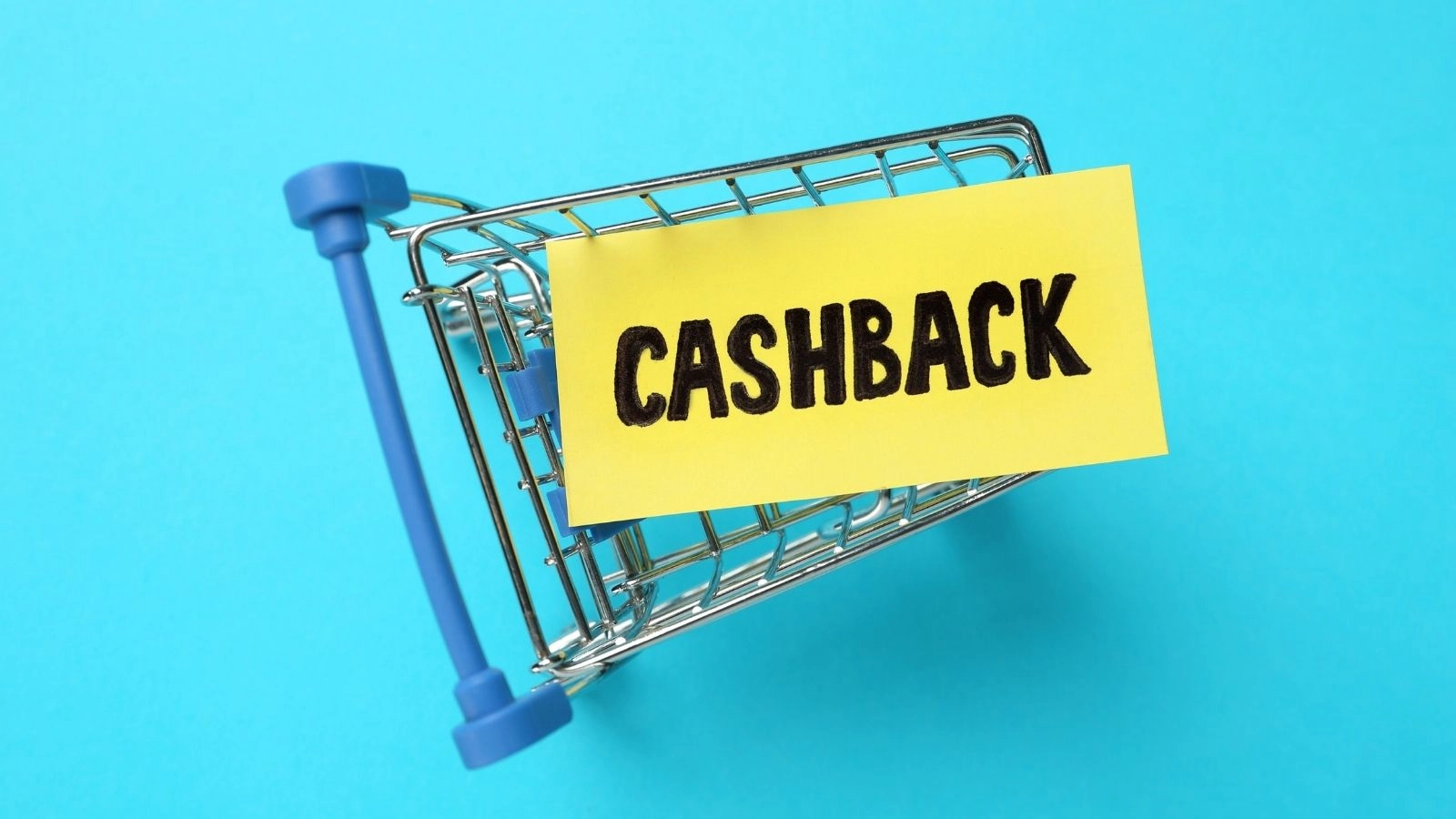
.webp)


